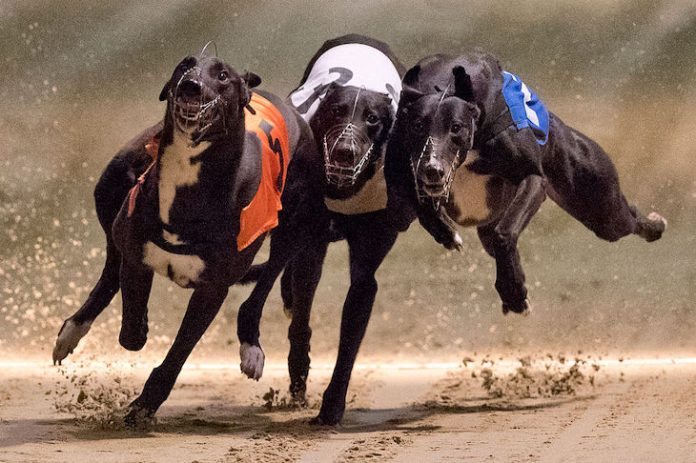The trap draws open. The long, slender bodies of the greyhounds bolt out in pursuit of the taunting, mechanical hare as a thunderous cheer erupts from the roaring crowd. But over the years, that roar has gotten quieter. Dog racing, once a form of public entertainment more popular than the cinema, is on its last legs.
Dog racing, once a form of public entertainment more popular than the cinema, is on its last legs
‘At one time in the UK it was the second-most popular sport behind football,’ said Greg Cruttwell, director of a documentary film on the sport, Going to the Dogs. ‘It has a unique place in British sporting history and culture. In its time, when there were tracks all around the country, it played a very important part in community life.’
Greyhounds are among the first dog breeds mentioned in English literature, listed among the monk’s possessions in the Canterbury Tales. But it wasn’t until the 1920s that dog racing as we know it came to be. That was when a keen-eyed American socialite named Charles Munn, noticing the British fondness for a pastime named ‘coursing’ (watching dogs sprint after hares), introduced audiences to the mechanical hare. The first greyhound races were held in Manchester in 1926, taking the spot once held by horse races, which were barred from taking place within ten miles of a city centre. The sport quickly became a national pastime. Millions flocked to the races. A few pooches, like Mick the Miller, achieved celebrity status, appearing in the 1935 film Wild Boy.
A day at the track was an opportunity to place bets, a fact which didn’t escape the attention of razor-wielding gangsters like the Sabini mob. The sport’s seedy underbelly was exaggerated by the press, it’s working-class reputation looked down upon. Winston Churchill derided it as ‘animated roulette’.
But the racetrack owners were earning a pile of money. In 1936, Romford racecourse owner Archer Leggett decided to ditch the dogs and bring cheetah racing to the UK, acquiring several from Kenya. The cheetahs left greyhounds absolutely in the dust. But when it came to racing one another, once it was obvious which of the big cats would catch the ‘prey’ first, the others simply lost interest and lay down. Audiences quickly grew tired of the predictable spectacle.
By the 1960s, dog race attendance halved from its heyday as legalised gambling provided other distractions, beckoning punters into casinos and the betting shops ubiquitous on the high street today. The decades after only brought decline. As the industry struggled to remain sustainable, rising property prices meant stadiums were bought out by developers. In the mid-20th century there were 33 racetracks in London alone: now only Romford remains.
The pandemic struck another blow. The races were still happening, but streamed online for audiences at home. The racecourse was once a family day out, or a chance to have a bit of fun with your mates, pint in hand. Watching it online mainly serves one purpose: gambling.
But there’s still a small, devoted following keeping the sport alive. ‘It was heartwarming and moving to see how much those within the sport love their dogs,’ said Cruttwell.
‘They’re devoted to them… [They] don’t do it for the money, which is nowhere near what it is in horse racing and many other sports. They do it 24/7, without ever taking holidays, because they love their dogs, who they truly believe love to race. As with a lot of sports, however, there have also been plenty of disreputable, dishonourable people involved in greyhound racing and the welfare of dogs has undoubtedly not been what it should have been up until recently.’
In 2006, the Sunday Times reported that a Durham man was taking greyhounds no longer fit for racing and shooting them in the head with a bolt gun, then burying them on his land for £10 each. The canine killer may have slain as many as 10,000 hounds. After the ensuing inquiry, an industry body, the Greyhound Board of Great Britain (GBGB), was established to keep checks on welfare.
But these are very different times, and animal rights campaigners say this hasn’t been enough. ‘Greyhound racing is inherently dangerous,’ said Alain Thomas, co-founder of Greyhound Rescue Wales. ‘You’ve got these tall skinny dogs hurtling around a track at 40 miles an hour. They’ve got tight bends on the track; collisions and falls are inevitable and when they happen, then injuries are inevitable and serious injuries and sometimes deaths as well. Apart from the traumatic serious injuries, that you see, there’s the ones that you don’t see until a lot later, and they’re caused by repetitive strain of running around an oval track in the same direction day after day, week after week…The function of the dogs is made clear: it’s exactly the same as the ball on a roulette wheel, except these are sentient beings and they suffer for it.’
The Welsh government has committed to banning the sport as soon as possible, perhaps as early as next year, and the Scottish government may follow. There are no such plans in England, but in any case, between track closures and falling interest, the sport is dying out on its own, anyway. According to a 2022 YouGov survey, nearly two-thirds of the public felt greyhound racing was ‘unimportant’ to British culture.
Perhaps this is the last lap.







